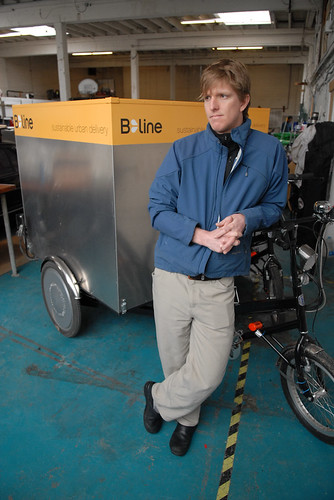Last week the Oregon Department of Transportation announced the availability of $4 million in incentives for electric trucks. The money comes from the federal government’s Congestion Mitigation and Air Quality (CMAQ) program and it’s aimed at, “encouraging the purchase of zero-emission urban delivery trucks.”
Unfortunately the money (which comes in the form of $20,000 vouchers per qualifying vehicle) cannot be used to purchase cargo trikes and other vehicles that use human-power in addition to electric assist. One stipulation of the grants is that the vehicles weight over 10,000 pounds.
The goal of this program is to reduce greenhouse gas emissions, so it seems promoting more freight to be delivered with pedal-powered trucks would make a lot of sense. It’s too bad that ODOT doesn’t yet embrace the type of freight vehicles used with much success by Portland companies like B-Line and Portland Pedal Power.
“By limiting the EV incentives to vehicles of 10,000 lbs or more, the current push for EV delivery fleets is short-sighted.”
— Franklin Jones, CEO of B-Line Sustainable Urban Delivery
I brought up this issue when I sat down with ODOT Director Matt Garrett back in April. He said that was the first he’d ever heard of using pedal-powered vehicles to deliver freight in urban areas and that folding such vehicles into ODOT’s suite of EV incentive programs had simply never been discussed.
I asked Franklin Jones, CEO and Founder of B-Line, for his reaction to ODOT’s new voucher program. He thinks ODOT is missing the boat (or should I say bike?).
Jones said he welcomes the new incentives because they will help reduce GHG emissions. But, he adds, “By limiting the EV incentives to vehicles of 10,000 lbs or more, the current push for EV delivery fleets is short-sighted.” Jones’ trikes weight about 500 pounds.
The way Jones sees it, ODOT’s push to promote a healthier planet misses key components. “A downtown traffic jam of EVs is still a traffic jam,” he says, “and a driver of an EV isn’t gaining the health and wellness associated with cycling.”
By switching to more electric trucks, there may be a reduction in emissions, but, Jones wonders, “Will the vehicular landscape of our city really be all that different? Will we relate to each other differently just because we drive EV’s?”
Jones is getting at some of the key attributes in investing in more pedal power that are often overlooked: more space for other things (more vehicles, more parks, more buildings), more public health benefits, and the greater sense of community that arises when people lose the steel shell of cars and trucks and see fellow citizens face to face and experience cities with more than just their eyes.
But this isn’t just a feel-good argument from Jones. He points to several others cities where pedal-powered freight delivery is taking off (MetroPed in Boston, Revolution Rickshaw in New York City, SHIFT Urban Delivery in Vancouver, BC, and so on). “There is a false assumption that there is no alternative for supplying goods and services into our urban core.”
In London, Office Depot has expanded their bike delivery fleet in anticipation of clogged streets during the Olympics.
And then there are the safety benefits of getting “killer trucks” of city streets, as highlighted in this article posted today on TreeHugger.com.
In the end, Franklin says he’s like to see ODOT adopt a broader definition of EVs and he’d like to see EV charging stations include ports appropriate for e-bikes.
“Both of these measures,” says Jones, “would go a long way to promoting a truly sustainable and prosperous city.”



